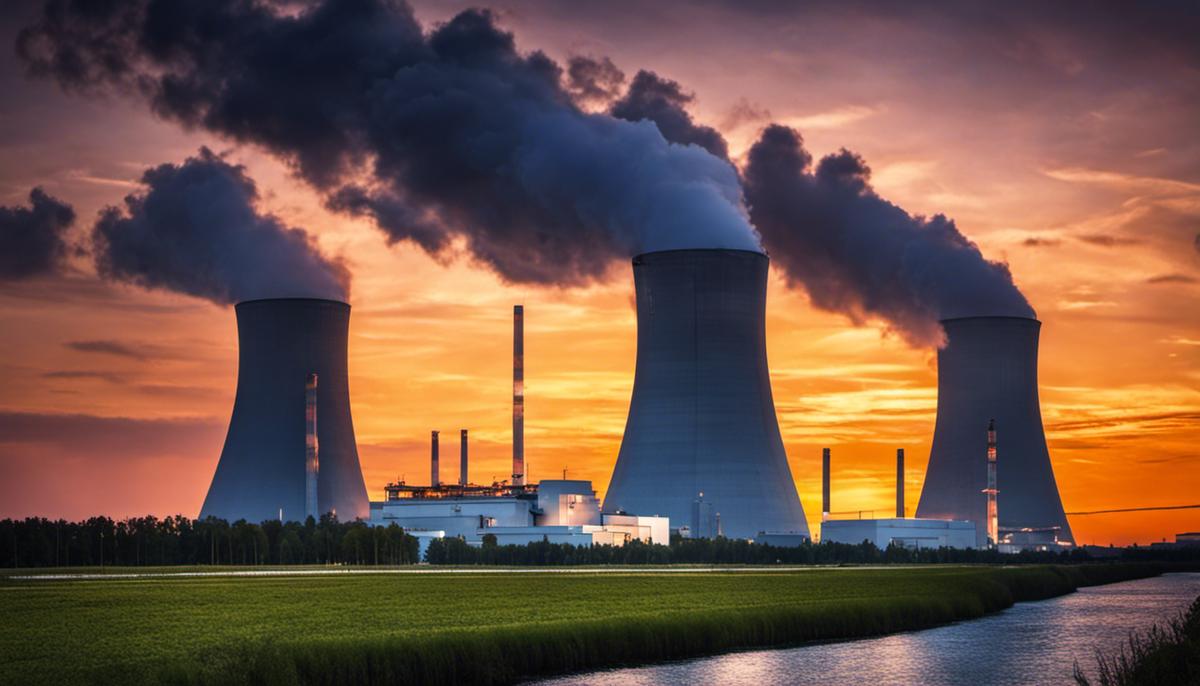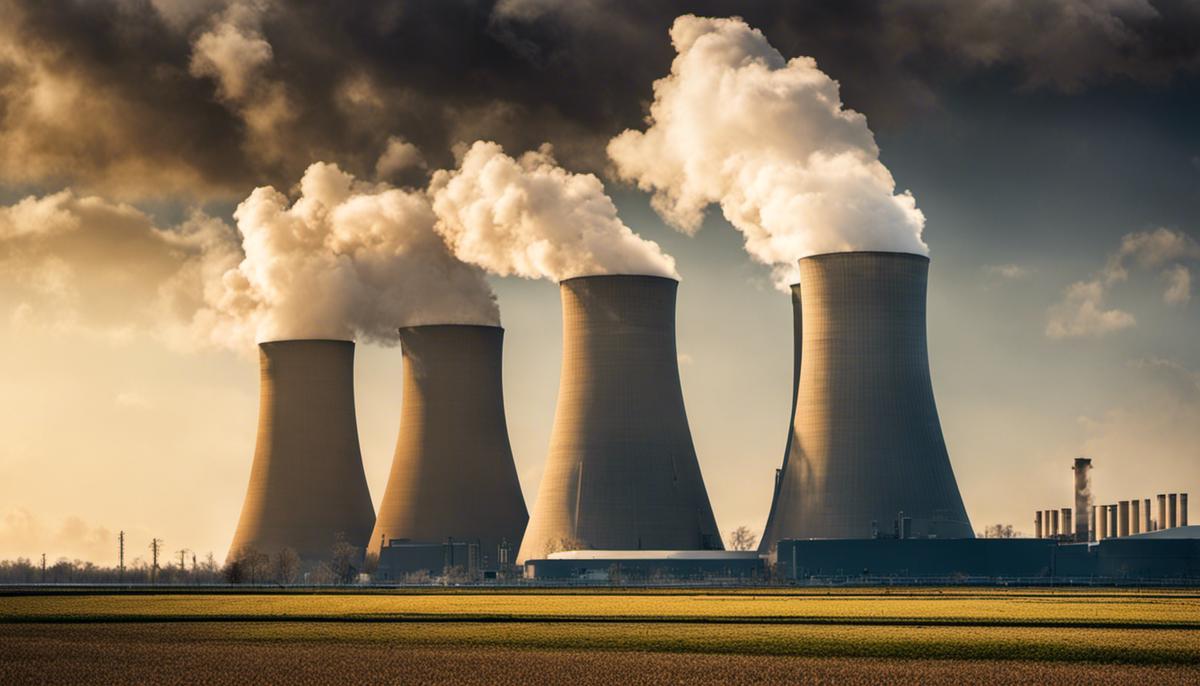The discussion about nuclear power plants continually orbits between fears of potential harm and the unneglectable benefits they offer. The modern world relies heavily on these nuclear juggernauts for a significant portion of its electricity needs. However, there is growing concern among the public about the long-term effects of living in the shadow of these colossal facilities. Through this exploration, we aim to demystify nuclear power plant operations, the possibility of radioactive emission effects, environmental consequences, socio-economic implications and the safeguarding measures employed in light of international standards, all in the context of residential proximity to these plants.
Table of Contents
Understanding Nuclear Power Plants
Influence of Nuclear Power Plant Functioning on Potential Risks for Proximity Inhabitants
Nuclear power plants stand as monoliths of engineering and scientific prowess, vital components in the worldwide power generation sphere. They offer an enormous potential to satiate energy needs with their constant and efficient energy production. However, their functioning inherently carries some level of risk, which holds notably profound implications for those residing within close spatial proximity. This examination seeks to understand and elucidate these potential risks.
Functioning of nuclear power plants relies fundamentally on nuclear fission: a process inducing the disintegration of an atomic nucleus and releasing an enormous amount of energy. The core of a nuclear power plant, the reactor, houses the fuel rods containing atomically heavy elements such as Uranium-235, which are subject to controlled fission reactions. During this process, a neutron bombards a nucleus, causing it to split and then release more neutrons to sustain the chain reaction. The resultant heat is leveraged to drive a turbine that produces electricity.
The foremost concern hailing from this operation emerges in the potential radiation exposure. Despite the meticulous care and rigorous safety mechanisms in place, unanticipated disruptions or accidents like reactor meltdowns, as unfortunately exemplified by Chernobyl and Fukushima, can disseminate radiation over large distances. Prolonged exposure to such radiation can be harmful, leading to a range of ailments from nausea to mutations and even life-threatening cancers.
Another source of radiation exposure is the operation-induced waste product. The fission process creates highly radioactive waste, requiring careful storage and containment for thousands of years. Any leakage of this waste, by accidental human error or natural disaster, can result in severe soil and water contamination, leading to potential bioaccumulation in the human food chain.
The generation of thermal pollution is another significant concern. The cooling process in a nuclear power plant releases vast quantities of heated water, causing a rise in ambient temperature in surrounding bodies of water. This sudden climatic shift can perilously disrupt the local ecosystem, resulting in harmful algal blooms and potentially decreasing biodiversity.
Finally, nuclear plants also have the potential to contribute to seismic activity. Construing a nuclear power plant is a massive task that induces geological imbalances. While most of these changes are often minimal in scale, there can be instances where the pressure or displacement might have far-reaching, detrimental ripple effects.
However, it is of utmost importance to highlight that these risks do not inherently negate the benefits of nuclear energy, like its significant contribution to carbon-free power generation. The emphasis, instead, should be on further honing safety protocols, stringent regulatory measures, and ongoing research aimed at innovations in reactor design and waste management, ensuring that nuclear power continues to play its part in the global energy ecosystem safely and sustainably. It is an endeavor worthy of our collective scientific intellect, toward a balanced coexistence of man, technology, and environment.

Impact of Radioactive Emission
Radiation Exposure: The Cumulative Consequences over Extended Periods
The hazardous influence of dense doses of radiation on living organisms is well-documented, as is the theatrical nuclear destruction conceived during the Cold War era. Nevertheless, the more subtle consequences of prolonged exposure to low doses of radiation warrant equally serious attention. This article focuses on the acute and chronic implications of such exposure, deepening the understanding of associated health risks.
Acute impacts of low-dose radiation exposure, often undetectable, can foment latent health hazards. A singular instance of such exposure might not cause immediate noticeable harm. However, an accumulation of these seemingly innocuous instances can eventuate in discernible biological transformations—cellular mutation being paramount among them.
Radioactive isotopes can inflict DNA damage, potentially inducing harmful mutations. In the short-term aftermath, this might not pose a significant threat, as the body’s self-repair mechanisms may rectify such alterations. Nevertheless, acute exposure to low-doses of radiation can gradually undermine these systems, augmenting the likelihood of erroneous repair and uncontrolled cell proliferation, thereby laying the groundwork for malignancies.
Conversely, the chronic implications of low-dose radiation exposure often emerge after a latency period. Chronic exposure can induce systemic health conditions, of which cancer is the most prominent. The propensity for cancer escalates in correspondence to prolonged radiation exposure, irrespective of the dose’s small magnitude. It’s estimated that roughly one-third of mutations in human gene-pool associated with leukemia are attributable to low-dose radiation exposure.
Moreover, cardiovascular diseases represent another health consequence linked to chronic exposure to low doses of radiation. Recent studies indicate that prolonged exposure can induce oxidative stress and inflammation, instigating atherosclerosis and other heart-related conditions. Despite the low dose, the cumulative exposure over time can silently erode cardiovascular health.
Admittedly, much remains to be discerned about the long-term effects of low-dose radiation exposure. Different radiation types, individual physiological responses, duration of exposure, and dose accumulation rates complicate preemptive measures and treatment protocols. Hence, it’s pertinent that research continues to unveil these complexities, refining our current understanding further and fostering measures to mitigate the associated risks.
In conclusion, while the ostensible menace of low-dose radiation might seem negligible, its cumulative and prolonged consequences are far from insignificant. Both acute and chronic health hazards manifest, leading to various complications ranging from cellular mutations and cardiovascular diseases to cancer. A comprehensive appreciation of these impacts equips us better for public health planning, prevention strategies, and managing the balance between utilizing nuclear power and safeguarding human health. With continued research and advancements, enhanced mitigation strategies portray a future where the benefits of nuclear energy can be fully reaped without compromising public health.

Environmental Consequences
Developing further in this exploration of the long-term impacts of nuclear power plant operations on the surrounding ecosystems, one must delve into the realm of bioaccumulation and biomagnification of radioactive materials.
Unavoidably, some level of radioactive isotopes can and does enter the surrounding environments, despite stringent safety practices; this is where the aforementioned phenomena come into play.
Bioaccumulation refers to the build-up of substances, such as radioactive isotopes, in an organism’s tissues.
Biomagnification elevates this process up the food chain; the concentration of these materials magnifies as one goes higher up in the trophic levels – from plants, to herbivores, and ultimately, carnivores.
Research has identified certain marine invertebrates and fish as particularly susceptible to bioaccumulation of radioactive isotopes.
In such situations, the dietary ingestion of contaminated fauna and flora escalates the concentration of the materials in the predator species.
A notorious example is the case of the Chernobyl disaster, where reindeer and consequently Sami people of Scandinavia bore the brunt of bioaccumulation and biomagnification of radioactive Cesium-137, due to their diet primarily composed of lichen and mushrooms.
This correlation between nuclear power plants and bioaccumulation is not limited to catastrophic failures.
Low-level exposure incidents or even controlled release of cooling water can lead to trace amounts entering the local ecosystem and initiating the bioaccumulation process.
It brings with it insidious repercussions, as these radioactive isotopes can persist in the environment for many years – some, like plutonium-239, for thousands of years.
This persistence results in long-term, chronic exposure for natural ecosystems and, certainly, humans residing nearby.
While the primary focus and fears typically revolve around immediate, acute effects of radiation exposure, such as lethality or visible mutations, chronic exposure to low-level radiation is a serious concern as well.
Several peer-reviewed studies suggest a link between chronic low-level radiation exposure and a reduction in animal and plant population viability, and damaging embryonic and juvenile stages of various species.
This degradation in local biodiversity could potentially cascade and disrupt the balance of the operation’s surrounding ecosystem.
Lastly, let it be pointed out that the impacts of nuclear power plants’ operation are not unilateral – it’s interconnected.
For example; thermal pollution may have indirect concurrent effects with radiation in the environment, amplifying the impacts on surrounding life.
Further research is vital in scrutinizing these synergistic impacts.
Understanding the vast range, depth, and complexity of these impacts is critical in guiding decision-making about existing and future nuclear power operations.
It warrants a holistic review of the energy production methods society employs, ever-weighing the necessity of energy production benefits against potential environmental costs.
Lastly, it emphasizes the ongoing significance of stringent safety standards and regulation in this field, curtailing potential damage, while encouraging the ceaseless pursuit of knowledge within nuclear science.

Impact on Socio-economic Factors
The Subtle Influences of Nuclear Power Plants on Local Economies and Social Well-being
One of the lesser-known yet significant implications of having a nuclear power plant in close geographical proximity is observable on local economies. Economically, nuclear power plants have a multifaceted impact characterized by both incremental benefits and substantial costs.
Rapid job creation is a salient feature attributed to the establishment of a nuclear power plant. This is not only in the nuclear plant itself, but extends to ancillary businesses in the vicinity that see a surge in demand due to an increased population of workers and their families. Sectors such as real estate, hospitality, retail, and services may enjoy a significant boost with the arrival of a nuclear power plant. Furthermore, the higher average wages of nuclear plant employees compared to workers in other industries can lead to an increase in disposable incomes, contributing positively to increased local spending and potentially raising the standard of living in these regions.
Economic fluctuations, however, are also evident in studies conducted around regions hosting nuclear power plants. The big-picture, long-term economic benefits are often offset by an economic ‘stigma effect.’ This effect manifests as a reluctance from businesses and individuals to invest or move within closer proximity to power plants, even despite robust regulatory measures and safety protocols. This economic hesitance might be particularly pronounced following high-profile nuclear accidents, regardless of how geographically distant they might be.
On a social welfare front, the presence of a nuclear power plant can produce tangible long-term effects on local communities. Schools in these areas often receive additional funding and see infrastructure enhancements courtesy of investments made by plant operators, as part of their corporate responsibility initiatives. This often results in improved educational standards in these areas.
Another less evident ramification is an increased sense of community cohesiveness induced by the shared experience of living in the shadow of a nuclear power plant. While this may seem counterintuitive, studies note an increased sense of civic responsibility and a deeper connection among residents, often leading to vibrant, tightly-knit communities. Communication and trust-building activities often conducted by power plant administrations amongst local communities are instrumental in fostering this sense of unity.
Despite the short-term economic benefits and the potential for enhanced social cohesion, these factors need to be considered against the backdrop of potential health risks and the possibility of adverse environmental effects. Every geographical region, community, and economic landscape will inevitably react uniquely to the presence of a nuclear power plant. To that end, comprehensive and transparent assessments of the multifaceted impacts of nuclear power plants are critical in policy-making and decision processes on future directions of energy production.
From an academic standpoint, further research to gain a more nuanced understanding of these socio-economic impacts is essential. Equally important is the need to effectively disseminate this knowledge to the public at large, fostering an educated conversation about nuclear energy’s role in our societies.

Consideration of Safety Measures and International Standards
While the aforementioned elements in the preceding parts provide a foundation upon which to evaluate the viability of nuclear energy, an understanding of how safety measures and international regulations function to mitigate the long-term health and environmental risks of living near nuclear power plants necessitates close examination. Fortunately, international regulatory bodies, scientific committees, and local government agencies have initiated comprehensive guidelines and regulations to ensure safety and mitigability of potential risks to communities near power plants.
The International Atomic Energy Agency (IAEA) has set guidelines to achieve safety objectives. Among these guidelines, the concept of Defence in Depth, an approach that amalgamates numerous levels of safety measures, is considerable. Consisting of five levels, this approach counteracts human and mechanical errors and protects against radiation hazards. This strategy ensures containment of radiation within the plant, reducing risk of exposure to the environment and nearby communities.
Furthermore, the World Association of Nuclear Operators (WANO) and the IAEA have instituted the Plant Operational Safety (POS) review to assess the compliance of nuclear power plants with safety objectives. The POS commits to an in-depth review of operational safety, fostering international standards by sharing strategies for best practices, and mitigating risks associated with reactor operations.
Regulation is not solely safety-centric; it also concerns the protection of the environment. Nuclear power plants predominantly engage in a closed coolant system approach, considerably minimizing thermal pollution. This approach, coupled with stringent regulatory monitoring, ensures ecosystems in the vicinity of these plants are less affected by thermal pollution.
Radiation protection regulations established by the International Commission on Radiological Protection (ICRP) also play a deleterious role. The regulations serve dual purposes: They protect individual living near nuclear power plants from radiation exposure and prevent harmful effects on surrounding fauna and flora. A system of ‘ Reference Animals and Plants ‘ was established by the ICRP ensuring that regulations encapsulate protection of the environment from Ionizing radiation, thus mitigating biodiversity risks.
Lastly, the IAEA and ICRP encourage communication between power plant operators and local communities. Regular meetings and open forums prop up trust between the entities, aid in addressing community concerns and educate the public about nuclear technology, safety measures and regulations for its anytime use.
Estimating economic aspects of power plants also contributes to the larger discourse. Nuclear power plants not only generate considerable employment opportunities but also contribute significantly to local economies. However, the economic stability of such regions may be affected by incidents at the nuclear facility or shifts in public perception towards nuclear energy. Thus, regular, transparent communications with local communities reinforce public understanding and acceptance of nuclear power.
In conclusion, active adherence to international safety guidelines and regulations, coupled with open and regular communication with local communities, ensures the substantial mitigation of the inherent risks associated with living near nuclear power plants. Future research may unveil novel methods of risk reduction and secure nuclear energy as a viable path to carbon-neutral power generation.

Through this thorough examination, one can discern that living near nuclear power plants brings both potential risks and inherent safeguards. A complex interplay of factors shapes the long-term effects, with critical components including the nature and extent of radioactive emissions, environmental repercussions, socio-economic impacts, and the effectiveness of safety measures and international standards in place. Woven from the understanding of nuclear power plant operations, this balanced perspective allows individuals to make an informed decision on residing near these power stations. Knowledge is power when it comes to understanding the implications of living beside these nuclear behemoths, and open dialogue helps create a future which safely utilize the immense power contained within the atom’s heart.

Rajan Moonbeam is a dedicated health writer with a Master of Public Health (MPH) degree. Specializing in holistic wellness and preventive care, Rajan combines scientific research with natural approaches to health, offering readers practical advice on living their healthiest life. His work is a beacon for those seeking to navigate the path to well-being with integrity and balance.

